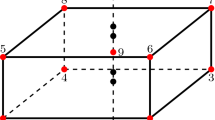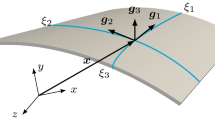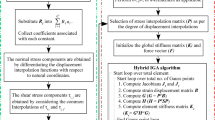Abstract
In isogeometric analysis (IGA), the functions used to describe the CAD geometry (such as NURBS) are also employed, in an isoparametric fashion, for the approximation of the unknown fields, leading to an exact geometry representation. Since the introduction of IGA, it has been shown that the high regularity properties of the employed functions lead in many cases to superior accuracy per degree of freedom with respect to standard FEM. However, as in Lagrangian elements, NURBS-based formulations can be negatively affected by the appearance of non-physical phenomena that “lock” the solution when constrained problems are considered. In order to alleviate such locking behaviors, the Assumed Natural Strain (ANS) method proposed for Lagrangian formulations is extended to NURBS-based elements in the present work, within the context of solid-shell formulations. The performance of the proposed methodology is assessed by means of a set of numerical examples. The results allow to conclude that the employment of the ANS method to quadratic NURBS-based elements successfully alleviates non-physical phenomena such as shear and membrane locking, significantly improving the element performance.














Similar content being viewed by others
References
Arnold D, Brezzi F, Fortin M (1984) A stable finite element for the stokes equations. Calcolo 21:337–344
Sussman T, Bathe KJ (1987) A finite element formulation for nonlinear incompressible elastic and inelastic analysis. Comp Struct 26:357–409
Bathe KJ (1996) Finite element procedures. Prentice Hall
Zienkiewicz OC, Taylor RL (2000) The finite element method: volume 1, the basis. McGraw-Hill, New York
Belytschko T, Bindeman LP (1991) Assumed strain stabilization of the 4-node quadrilateral with 1-point quadrature for nonlinear problems. Comp Methods Appl Mech Eng 88(3):311–340
Belytschko T, Wong BL, Chiang HY (1992) Advances in one-point quadrature shell elements. Comp Methods Appl Mech Eng 96(1):93–107
Belytschko T, Leviathan I (1994) Physical stabilization of the 4-node shell element with one point quadrature. Comp Methods Appl Mech Eng 113(3–4):321–350
Liu WK, Hu Y-K (1994) Multiple quadrature underintegrated finite elements. Int J Numer Methods Eng 37(19):3263–3289
Wriggers P, Eberlein R, Reese S (1996) A comparison of three-dimensional continuum and shell elements for finite plasticity. Int J Solids Struct 33(20–22):3309–3326
Liu WK, Guo Y, Tang S, Belytschko T (1998) A multiple-quadrature eight-node hexahedral finite element for large deformation elastoplastic analysis. Comp Methods Appl Mech Eng 154(1–2):69–132
Reese S, Wriggers P, Reddy BD (2000) A new locking-free brick element technique for large deformation problems in elasticity. Comp Struct 75(3):291–304
Reese S (2002) On the equivalence of mixed element formulations and the concept of reduced integration in large deformation problems. Int J Nonlinear Sci Numer Simul 3(1):1–33
Hughes TJR (1977) Equivalence of finite elements for nearly incompressible elasticity. J Appl Mech 44:1671–1685
de Souza Neto EA, Peric D, Dutko M, Owen DRJ (1996) Design of simple low order finite elements for large strain analysis of nearly incompressible solids. Int J Solids Struct 33(20—-22):3277–3296
de Souza Neto EA, Andrade Pires FM, Owen DRJ (2005) F-bar-based linear triangles and tetrahedra for finite strain analysis of nearly incompressible solids. Part I: formulation and benchmarking. Int J Numer Methods Eng 62(3):353–383
Simo JC, Rifai MS (1990) A class of mixed assumed strain methods and the method of incompatible modes. Int J Numer Methods Eng 29(8):1595–1638
Simo JC, Armero F (1992) Geometrically non-linear enhanced strain mixed methods and the method of incompatible modes. Int J Numer Methods Eng 33(7):1413–1449
Korelc J, Wriggers P (1996) An efficient 3D enhanced strain element with Taylor expansion of the shape functions. Comput Mech 19:30–40
Roehl D, Ramm E (1996) Large elasto-plastic finite element analysis of solids and shells with the enhanced assumed strain concept. Int J Solids Struct 33(20–22):3215–3237
Armero F, Dvorkin EN (2000) On finite elements for nonlinear solid mechanics. Comput Struct 75(3):235
Kasper EP, Taylor RL (2000) A mixed-enhanced strain method: Part I: geometrically linear problems. Comput Struct 75(3):237–250
Piltner R (2000) An implementation of mixed enhanced finite elements with strains assumed in Cartesian and natural element coordinates using sparse B-matrices. Eng Comput 17:933–949
Alves de Sousa RJ, Natal Jorge RM, Fontes Valente RA, Csar de S JMA (2003) A new volumetric and shear locking-free 3D enhanced strain element. Eng Comput 20(7):896–925
Fontes Valente RA, Natal Jorge RM, Cardoso RPR, Cesar de Sa JMA, Gracio JJA (2003) On the use of an enhanced transverse shear strain shell element for problems involving large rotations. Comput Mech 30:286–296
Fontes Valente RA, Alves De Sousa RJ, Natal Jorge RM (2004) An enhanced strain 3D element for large deformation elastoplastic thin-shell applications. Comput Mech 34:38–52
Alves de Sousa RJ, Cardoso RPR, FontesValente RA, Yoon J-W, Grcio JJ, Natal Jorge RM (2005) A new one-point quadrature enhanced assumed strain (EAS) solid-shell element with multiple integration points along thickness: part I—geometrically linear applications. Int J Numer Methods Eng 62(7):952–977
Alves de Sousa RJ, Cardoso RPR, Fontes Valente RA, Yoon JW, Grcio JJ, NatalJorge RM (2006) A new one-point quadrature enhanced assumed strain (EAS) solid-shell element with multiple integration points along thickness. Part II: nonlinear applications. Int J Numer Methods Eng 67(2):160–188
Korelc J, Ursa A, Wriggers P (2010) An improved EAS brick element for finite deformation. Comput Mech 46:641–659
Hughes TJR, Tezduyar TE (1981) Finite elements based upon Mindlin plate theory with particular reference to the four-node bilinear isoparametric element. J Appl Mech 48(3):587– 596
Dvorkin Eduardo N, Bathe Klaus-Jrgen (1984) A continuum mechanics based four-node shell element for general non-linear analysis. Eng Comput 1:77–88
Hauptmann R, Schweizerhof K (1998) A systematic development of ’solid-shell’ element formulations for linear and non-linear analyses employing only displacement degrees of freedom. Int J Numer Methods Eng 42(1):49–69
Sze KY, Yao LQ (2000) A hybrid stress ANS solid-shell element and its generalization for smart structure modelling. Part I: solid-shell element formulation. Int J Numer Methods Eng 48(4):545–564
Cardoso RPR, Yoon JW, Mahardika M, Choudhry S, Alvesde Sousa RJ, FontesValente RA (2008) Enhanced assumed strain (EAS) and assumed natural strain (ANS) methods for one-point quadrature solid-shell elements. Int J Numer Methods Eng 75(2):156–187
Schwarze M, Reese S (2009) A reduced integration solid-shell finite element based on the EAS and the ANS concepts: geometrically linear problems. Int J Numer Methods Eng 80(10):1322–1355
Schwarze M, Reese S (2011) A reduced integration solid-shell finite element based on the EAS and the ANS concepts: large deformation problems. Int J Numer Methods Eng 85(3):289–329
Vu-Quoc L, Tan XG (2003) Optimal solid shells for non-linear analyses of multilayer composites I—statics. Comput Methods Appl Mech Eng 192(9–10):975–1016
Reese S (2007) A large deformation solid-shell concept based on reduced integration with hourglass stabilization. Int J Numer Methods Eng 69(8):1671–1716
Harnau M, Schweizerhof K (2006) Artificial kinematics and simple stabilization of solid-shell elements occurring in highly constrained situations and applications in composite sheet forming simulation. Finite Elem Anal Des 42(12):1097–1111
Hughes TJR, Cottrell JA, Bazilevs Y (2005) Isogeometric analysis: CAD, finite elements, NURBS, exact geometry and mesh refinement. Comput Methods Appl Mech Eng 194:4135–4195
Cottrell JA, Hughes TJR, Bazilevs Y (2009) Isogeometric analysis: toward integration of CAD and FEA. Wiley, Hoboken
Cottrell JA, Reali A, Bazilevs Y, Hughes TJR (2006) Isogeometric analysis of structural vibrations. Comput Methods Appl Mech Eng 195:5257–5296
Cottrell JA, Hughes TJR, Reali A (2007) Studies of refinement and continuity in isogeometric structural analysis. Comput Methods Appl Mech Eng 196:4160–4183
Echter R, Bischoff M (2010) Numerical efficiency, locking and unlocking of NURBS finite elements. Comput Methods Appl Mech Eng 199(5–8):374–382
Elguedj T, Bazilevs Y, Calo VM, Hughes TRJ (2008) B-bar and F-bar projection methods for nearly incompressible linear and nonlinear elasticity and plasticity using higher-order nurbs elements. Comput Methods Appl Mech Eng 197:2732–2762
Taylor RL (2011) Isogeometric analysis of nearly incompressible solids. Int J Numer Methods Eng 87(1–5):273–288
Rui PR, Cardoso, Csar de S JMA (2012) The enhanced assumed strain method for the isogeometric analysis of nearly incompressible deformation of solids. Int J Numer Methods Eng 92(1):56–78
Beir da Veiga L, Lovadina C, Reali A (2012) Avoiding shear locking for the timoshenko beam problem via isogeometric collocation methods. Comput Methods Appl Mech Eng 241—-244(0):38–51
Auricchio F, Beir da Veiga L, Kiendl J, Lovadina C, Reali A (2013) Locking-free isogeometric collocation methods for spatial timoshenko rods. Comput Methods Appl Mech Eng 263:113–126
Bouclier Robin, Elguedj Thomas, Combescure Alain (2012) Locking free isogeometric formulations of curved thick beams. Comput Methods Appl Mech Eng 245–246:144–162
Bouclier R, Elguedj T, Combescure A (2013) On the development of NURBS-based isogeometric solid shell elements: 2D problems and preliminary extension to 3D. Comput Mech p 1–28
Echter R, Oesterle B, Bischoff M (2013) A hierarchic family of isogeometric shell finite elements. Comput Methods Appl Mech Eng 254:170–180
Thai CH, Nguyen-Xuan H, Nguyen-Thanh N, Le T-H, Nguyen-Thoi T, Rabczuk T (2012) Static, free vibration, and buckling analysis of laminated composite reissner-mindlin plates using NURBS-based isogeometric approach. Int J Numer Methods Eng 91(6):571–603
Saman H Remmers JJC, Verhoosel CV, de Borst R (2013) An isogeometric solid-like shell element for nonlinear analysis. Int J Numer Methods Eng 95(3):238–256
Benson DJ, Bazilevs Y, Hsu MC, Hughes TJR (2011) A large deformation, rotation-free, isogeometric shell. Comput Methods Appl Mech Eng 200(13–16):1367–1378
Benson DJ, Hartmann S, Bazilevs Y, Hsu MC, Hughes TJR (2013) Blended isogeometric shells. Comput Methods Appl Mech Eng 255:133–146
Piegl L, Tiller W (1997) The NURBS book. Springer, New York
Rogers DF (2001) An introduction to NURBS with historical perspective. Academic Press, London (1993)
Bucalem ML, Bathe K-J (1993) Higher-order MITC general shell elements. Int J Numer Methods Eng 36(21):3729–3754
Borden MJ, Scott MA, Evans JA, Hughes TJR (2011) Isogeometric finite element data structures based on bzier extraction of nurbs. Int J Numer Methods Eng 87(1—-5):15–47
Kiendl J, Bletzinger K-U, Linhard J, Wuchner R (2009) Isogeometric shell analysis with Kirchhoff-Love elements. Comput Methods Appl Mech Eng 198(49–52):3902–3914
Belytschko T, Stolarski H, Liu WK, Carpenter N, Ong JS-J (1985) Stress projection for membrane and shear locking in shell finite elements. Comput Methods Appl Mech Eng 51:221–258
Scordelis AC, Lo KS (1969) Computer analysis of cylindrical shells. J Am Concr Inst 61:539–561
Acknowledgments
The authors gratefully acknowledge the support given by the Ministrio da Educao e Cincia, Portugal, under the Grants SFRH/BD/70815/2010 and PTDC/EMS-TEC/0899/2012, as well as by the European Research Council through the Project ISOBIO No. 259229.
Author information
Authors and Affiliations
Corresponding author
Rights and permissions
About this article
Cite this article
Caseiro, J.F., Valente, R.A.F., Reali, A. et al. On the Assumed Natural Strain method to alleviate locking in solid-shell NURBS-based finite elements. Comput Mech 53, 1341–1353 (2014). https://doi.org/10.1007/s00466-014-0978-4
Received:
Accepted:
Published:
Issue Date:
DOI: https://doi.org/10.1007/s00466-014-0978-4




